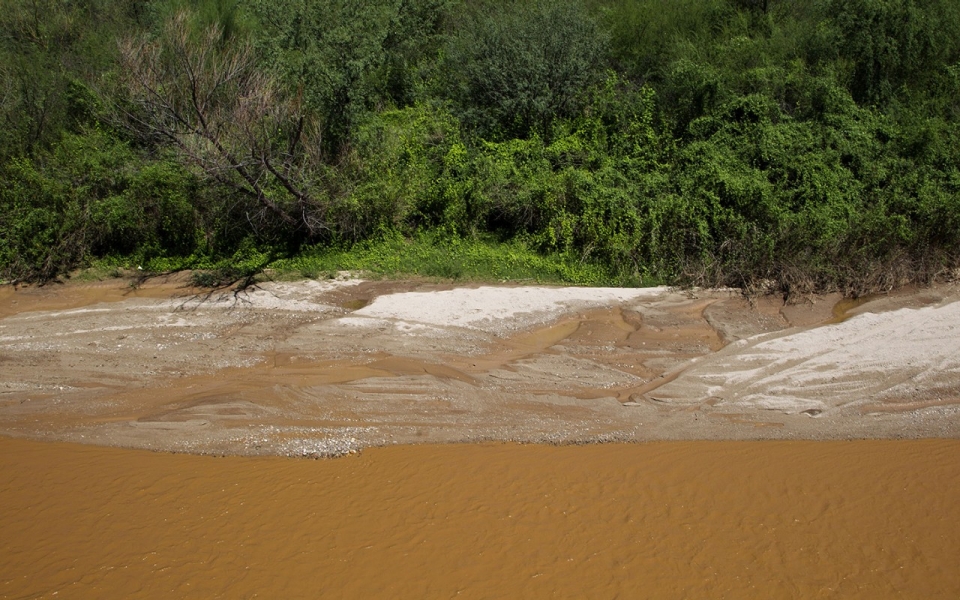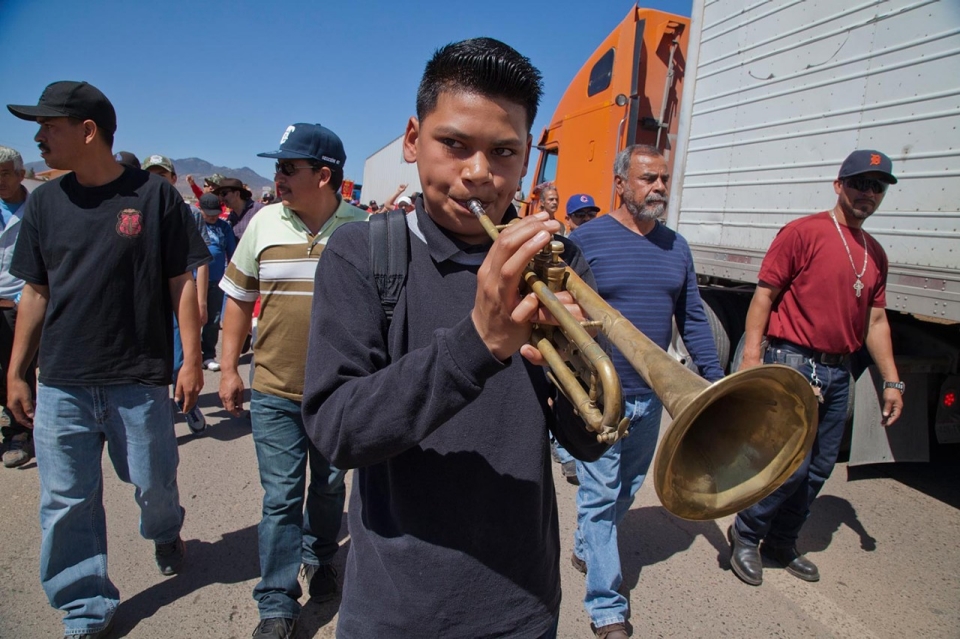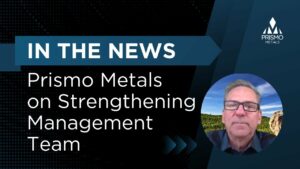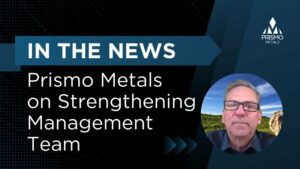
Striking miners march at the huge Cananea copper mine in Sonora, Mexico, on March 27, 2015.
© 2015 David Bacon

An overview of the plantón near the mine.
David Bacon
CANANEA, Mexico — The pipes have gone silent. Gone is the hum of water flowing through them to the world’s second-largest copper mine, just south of the U.S. border. Instead, in the normally empty desert here, tents and buses line the highway. Dust and smoke from cooking fires fill the air while hundreds of people listen to speeches and discuss the day’s events.
This plantón, or occupation, which began on March 18, has shut down most operations at the Cananea mine, which consumes huge quantities of water pumped from 49 wells across the desert in order to extract copper concentrate from crushed ore.
Many of the people involved in the plantón are miners who have been on strike since 2008, when they walked out because of dangerous working conditions. Two years later, the government brought in 3,000 federal police, drove miners from the gates and occupied the town. Since then Cananea has been operated by contracted laborers recruited from distant parts of the country. But the strike has continued, as miners struggle to survive in this small mountain town where the mine is virtually the only source of work.
Now, for the first time in five years, the mine is again paralyzed. This time, strikers didn’t stop its operation by themselves. Half the people with them are farmers — residents of the Rio Sonora Valley, angry over a toxic spill that upended their lives last August, causing health problems and economic devastation.
People in the towns along the river used to have little involvement with the miners, but the spill gave them common ground. This alliance between miners and angry farmers also includes a U.S. union, the United Steel Workers. Together they are challenging the Mexican government’s fundamental rule for economic growth — that workers’ rights and environmental protections must be subordinate to the needs of corporate investors.
Sergio Tolano, general secretary of Cananea’s Local 65 of the miners’ union, says, “In Mexico you’re supposed to respect the law. But what’s the truth? There’s no protection for the lives of the workers or of the communities affected by pollution.”
Beginning on Aug. 6 of last year, 10.5 million gallons of concentrated sulfuric acid and heavy metals escaped from a holding pond at the mine. The toxic mix flowed into the headwaters of the Sonora River, affecting 24,000 people who live in 45 towns along its banks.

The Sonora River, Aug. 12, 2014, a few days after the Cananea mine leaked 10.5 million gallons of sulfuric acid into the water.
Hector Guerrero / AFP / Getty Images

The face of the copper mine.
Hector Guerrero / AFP / Getty Images
Arturo Rodriguez, of the office of the Mexican attorney general for environmental protection, told The Associated Press that the cause was lax supervision at Cananea, compounded by rain and defective construction.
Grupo México, the company that owns the mine, didn’t respond to requests for comment, but according to Yahoo News, Juan Rebolledo, vice president for international relations, said that the acid wasn’t toxicand “there’s no problem, nor any serious consequence for the population, as long as we take adequate precautions.” Grupo México’s solution was to pour calcium into the river to neutralize the acid.
Miners charge, however, that the workers for Tecovifesa, a construction contractor employed by Grupo México since the strike, lacked experience in dealing with mines’ toxic-waste ponds. “Before the strike, experienced union members who were direct employees did all the work,” says striker Sergio Martinez, who worked at Cananea for 13 years.
The company waited a day after the spill to inform authorities and two days to alert townspeople. Many only discovered what had happened when the water turned orange. “Our children were at the river that day,” remembers Reyna Valenzuela, from the town of Ures. “We didn’t know they would be affected, because the company didn’t tell anyone.” The children broke out in rashes, she says, which doctors eventually told her were due to heavy-metal exposure. Other residents began to experience more serious health problems.
In December, Tolano and other union leaders began discussing plans to shut down the mine. This winter, strikers and community leaders called meetings in town plazas and made speeches broadcast with speakers rigged to the back of pickup trucks, discussing the impact of the spill with residents. On March 18, buses filled with several hundred farmers headed from the towns toward Cananea. Alerted to their arrival, the mine’s managers called in hundreds of police to keep the strikers from blocking the gates.
But the protesters outflanked the cops and roared down the highway to the lightly guarded pumping station. Facing hundreds of angry miners and farmers, the operators shut down the pumps and fled. And as the pumps fell quiet, so did 80 percent of the operations at the mine.

Rios Leon holds a list of what he says were the heavy metals found in a test of his blood.
David Bacon
Schoolchildren all over this country learn that the first battle of the Mexican Revolution was fought here in Cananea, when a miners’ insurrection challenged the operation’s U.S. owner, Col. William Greene, in 1906. In the years since, the mine has belonged to U.S. corporations and then the Mexican government. In 1990 the mine was sold to Grupo México, a corporation headed by Mexican mining tycoon German Larrea, for $475 million, about a quarter of its market value.
Grupo México produces two-thirds of Mexico’s copper and says it has the largest copper reserves in the world. It bought the U.S. mining corporation American Smelting and Refining Co., or ASARCO, in 1999 and now owns mines in Arizona. It operates the world’s fifth-largest copper mine in Peru and is negotiating to buy others in Spain.
In 1998, miners struck in Cananea to stop reductions in the workforce, meant to cut labor costs. After Grupo México asked the government to call in troops to break the strike, approximately 800 miners were laid off. Union leaders were blacklisted. According to Carlos Navarette, one of the organizers of the plantón, “The company blacklisted us throughout the whole country.” In one job interview, he says, “The person interviewing me asked me where I was from, and I told him from the south. But then he saw my name on his computer. He said, ‘There’s no work for you here.’”
The current strike began in 2008 over health and safety concerns. Miners charged the company disconnected the huge pipes that extract dust from the buildings where ore is crushed. Dust buildup can permanently damage miners’ lungs. A study by a team of U.S. and Mexican health experts found “a significant percentage of this population may have radiologic silicosis.”

A drum and bugle corps marched with the miners and farmers on March 27, 2015.
David Bacon

Some of the miners rode their horses in the march.
David Bacon
Under Mexican law, an enterprise on strike cannot continue to function, so the mine’s operations were halted. But Grupo México asked the administration of then-President Felipe Calderón to declare the strike illegal. In spite of court decisions upholding its legality, the government complied. Police drove miners from the gates in 2010 and the mine was reopened with contracted labor.
Since strikers make up most of the population of Cananea, the company brought workers from southern Mexico to replace them. Grupo México created a new business entity to hire them through contractors. Sergio Martinez says that before the strike, miners got a base pay of 1,800 pesos ($128) for working eight hours a day, six days a week. With a productivity bonus, they earned at least 3,000 pesos weekly. Today, the contracted employees earn only 1,200 pesos a week, says Martinez, and work 12 hours a day instead of eight. The government authorized the creation of a company union, which signed a contract with Grupo México at the new lower wages. Adjusted for inflation, the average wage in mining nationally is 21 percent lower today than it was in 1978.
Says another miner, who asked to remain anonymous, “90 percent of the people now working in the mine are from far away. This is very humiliating for people here. You have kids and there’s no work for them either.” Like many others, this worker crossed the border without documents to find a job in Arizona. “I left my family here. The pain of our separation can’t be compared to anything,” he says.

Reyna Valenzuela, in white, with her children, Gladys and Roman, in green, and husband Juan Piña.
David Bacon
In addition to her children’s medical problems, Valenzuela’s family business, which made sweets and cheese, folded when customers in the state capital, hearing of the spill, didn’t want to buy any products from the river towns. Valenzuela went to the mine to ask for money to take her children to Phoenix, Arizona, where hospitals can perform more sophisticated blood tests for chemical exposure.
“The miners helped us and gave us a place to stay,” she recalls, but when they went to the mine’s director, José Julián Chavira, “they wouldn’t even talk with us.” She became one of the first participants in the plantón.
Laura Gutierrez is still outraged about the spill. “Our town, San Rafael, is made up of farmers,” she says. “We plant corn and peanuts, and we didn’t harvest anything last year. … Now we have nothing to live on.” Farmers in the area aren’t even planting this spring, because they fear the water is contaminated.
“This was an extremely toxic brew that went into the river,” according to Garrett Brown, director of the Maquiladora Health and Safety Support Network and a former inspector for the California Division of Occupational Safety and Health. “Lead causes serious and permanent damage to children. Cadmium is a known carcinogen.” The spill deposited heavy metals along hundreds of miles of riverbanks and into the aquifer.
After the spill, the authorities closed down 300 wells in the river towns. Grupo México’s website says the company distributed 164 million liters of water for free and installed 58 tanks of 5,500 gallons each in schools. The company also set up a $150 million fund to pay damages to residents and paid a fine of $2 million.
But some residents say they haven’t received any money, while others charge that after the drinking water supplied by Grupo México ran out they had to buy their own. “Right now we’re paying 25 pesos for a gallon of water,” Gutierrez says. “People who don’t have the money can’t buy it. We haven’t received a peso from the fund. No one I work with has.”
The purpose of the plantón, says Tolano, is not just to stop the mine’s operation. The union and residents have organized a coalition, the Sonora River Front, which is demanding that the government force Grupo México to clean up the river and take responsibility for the health and lost income of residents. It also seeks to restore the strikers to their jobs.
“Because the miners are supporting us, we’re supporting them,” Valenzuela says. “If we all get together, we can do something here. The whole Rio Sonora is with them.”
This effort also includes the U.S. union for copper miners, the United Steel Workers. Manny Armenta, a USW representative, has helped the local union in Cananea since the strike started. The night the police broke the lines at the gate in 2010, he led families out of the union hall to safety.
“You could smell the tear gas all over,” he recalls. “It was like a military occupation.” At the march to the pumping station, Armenta spoke to the crowd. “The government and Grupo México are making history,” he said, “but backwards, taking away the right to strike and the right to industrial safety.”
The U.S. union has given sanctuary to the head of the national miners’ union, Napoleón Gómez Urrutia. After 65 miners died in a 2006 explosion at Grupo México’s Pasta de Conchos coal mine in Coahuila, about 50 miles from the Texas border, Gómez accused the corporation and government of “industrial homicide.” Workers had complained of gas leaks and struck repeatedly over safety concerns. Five days after the explosion the company halted rescue efforts, and the government announced the mine would be closed.
Within weeks, the conservative administration of President Vicente Fox charged Gómez with fraud, and he left Mexico to escape arrest. Courts have found all charges against him groundless, and he has been re-elected union president several times. Nevertheless, he continues to stay in Vancouver, British Columbia, as a guest of the United Steel Workers, worried that the government and Grupo México will find another pretext for jailing him should he return.
The U.S. union is trying to renegotiate its contract with Grupo México’s ASARCO. Two years ago, the Mineros, the national miners’ union, and the USW agreed to join to form a single union. The merger has not been completed, but they now support each other in dealing with their common employers and look to the day when their bargaining can be coordinated.
Tolano credits this alliance with keeping the strike in Cananea alive. “Some of us have had a very hard time, but due to our tradition of supporting each other we’ve been able to take care of ourselves,” he says. “There have been divorces. Some people have lost their homes. But we’re still here.”
Original Article: http://america.aljazeera.com/articles/2015/4/15/unlikely-alliance-in-the-copper-mining-town-of-cananea-mexico.html
























